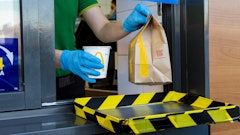
Unsaleable products used to be considered one of the costs of doing business. Not anymore. The price is strangling margins and action is imperative.
According to the Joint Unsaleables Report of 2008 undertaken by the Grocery Manufacturers Association and the Food Marketing Institute, the cost to the food industry is about $15 billion annually [extrapolated based on 2006 food and beverage and health and beauty sales of $1.23 trillion and the survey retailer weighted average unsaleables rate of 1.21 percent], or 1 percent to 2 percent of gross sales, on average.
The good news is the report's assertion is that these dramatic costs are avoidable. So what are companies doing about reducing and eliminating these phantom villains to the bottom line?
Unsaleables are defined as products that are removed from the supply chain because they have expired, or have been damaged or discontinued. This article will examine methods to prevent damaged unsaleables. It might seem too simple to state, but the first step requires getting back to basics. This means examining your supply chain to identify where, why, and how damages are occurring.
Best Practices: First Line Of Defense
Having analyzed the movement of products along the supply chain for over 20 years, Inmar Inc. developed a list of five best practices that should be considered holistically, suggests Mike Rawlins, senior director for supply chain services for the Winston-Salem, NC-based company. "These are the common themes we continue to see in the data we receive from our food manufacturer clients," he says.
The first step to best practices is to maintain and calibrate equipment regularly. Rawlins points to frequent situations involving malfunctioning case-folding and case-sealing equipment that can cause damaged products downstream. Secondly, maintain pallet quality so damaged and sub-standard pallets do not enter the supply chain.
Third, make sure to use wrap properly for unitizing. "Tying it to pallets to increase the stability of unit loads so product won't slide off a pallet during transportation can reduce damage significantly," Rawlins advises. "Also make sure the wrap is pre-stretched and appropriate force-to-load stretch wrapper settings are used with respect to product weight, density, and shipper-case design. This is an area of inherent weakness almost inevitably through most manufacturing environments."
Fourth, don't allow damaged shipping units and cases into the supply chain in the first place. "This means don't allow these damaged items to be loaded into trailers," Rawlins continues. "Doing this doesn't cost any money, yet it can result in millions of dollars of savings." So make sure your workforce understands the importance of catching these potential cost-producers at the point of loading trailers.
Finally, make sure loads and bulkheads are stabilized. If airbags are being used, they should be blown up properly and stabilized between pallets. Decisions made at this point can have positive or devastating effects once the customer receives the shipment, Rawlins says. "These five points are the first line of defense that should be orchestrated together. Everything you can fix here will have a positive and rippling effect along the supply chain."
Gentlemen, Tear Down Your Silos!
Once you have followed best practices, it's time to think about unit load design. According to the Center for Unit Load Design at Virginia Tech in Blacksburg, VA, the efficiency of unit load material handling is based on the interactive performance of packaging, pallets, and material handling equipment. The Center is the nation's only laboratory with facilities to evaluate all aspects of unit load and material handling design and efficiency.
Ralph Rupert, director of the Center, explains that packaging, pallets, and material handling systems are designed separately at different locations by different teams of individuals with no consideration given to how the components will interact with each other throughout the supply chain. Such a siloed approach creates mismatched systems.
"This causes inefficient unit load handling practices because you are not considering the total system of the load on the pallet, the type of pallet you require, and the distribution system the pallet will move through," Rupert explains. "When these components don't converse with one another, they create a system with inherent increased costs and increased damage rates." He notes that companies are beginning to understand the consequences of approaching their supply chain from a siloed perspective. "But we still have a long way to go."
In an effort to help companies tear down these silos, the Center for the last eight years has offered a seminar focused on the total systems approach. The Unit Load Design Short Course, designed for industry professionals, is offered twice a year. "We hope to educate the industry about how not to establish a system that is counterproductive to the systems-based approach," Rupert reports. "The sad truth is people get rewarded for saving their respective dollar spend in packaging, pallets and material handling systems while not realizing they are creating the situation for unsaleables."
Pallets: Kinks In The Chain
Once products are placed on pallets, it is assumed they will arrive at their destinations on-time, safe and undamaged. But in the real world, that is not always the case. The folks at CHEP USA understand this all too well, having invested in studies to help food companies reduce and eliminate unsaleables.
CHEP conducted its first study in unsaleables in 2003 and updated the study in 2006. The company is a regular contributor to the Joint Industry Unsaleables Management Conference. "About 18 months ago we hired the two major players in damage reclamation and reverse logistics: Inmar and Genco Supply Chain Solutions," notes Derek Hannum, director of marketing for the Orlando, FL-based company. "We wanted to understand the contribution CHEP is making in unsaleables reduction by having them study the relationship between our pallets, unit load design and product damage."
The study concluded that about 0.82 percent of products shipped on traditional white wood pallets qualify as damaged vs. 0.54 percent of products shipped on CHEP pallets (equating to 34 percent less damage).
"This is significant from a dollar perspective because of the volumes we are talking about," says Hannum. "Percentage points of improvement equate to tens of millions of dollars in unsaleable products." The study also concluded that 38 percent of product damage happens on 18 percent of unit loads due to poor unit load design.
Its innovation center examines and evaluates unit load design using its proprietary software to optimally design top board spacing to reduce the potential for the edge of a case falling into a gap that can cause creased cases and ultimate unsaleables. Hannum reports that CHEP pallets are designed with 76 percent more top-deck coverage than traditional one-way pallets or limited-use pallets.
There is also a double-whammy effect inherent in unsaleables. Because companies continue to optimize their supply chains, they operate under a model that eliminates overstocks and excess inventories. So when products wind up as unsaleables, they never reach the consumer because of the increased potential for out-of-stocks and lost sales, says Hannum.
Recognizing the amount of damage caused when material handling equipment comes in contact with pallets and products, CHEP engineered a small device called the Blue Guardian that reduces pallet and product damage. It is distributed exclusively through the Raymond Corp.
Plastic pallets also play a role in the food supply chain. ORBIS manufactures reusable plastic containers, crates, pallets, and bulk containers that retailers return to the company once products have been delivered. "We take a holistic end-to-end view of the supply chain through our relationships with manufacturers, growers, distributors, and warehouses," reports Bob Klimko, director of marketing for the Oconomowoc, WI-based company.
ORBIS helps its customers choose the right application by first auditing the portion of the supply chain a customer needs to understand better, says Klimko. "Unsaleables and damaged products are areas we explore within our audit process conducted by our packaging engineers."
Assuring Packaging Quality
Today's packaging might appeal to consumers because of its colorful and clever designs. But there is a lot of engineering going on behind the scenes. "The role of packaging is to protect the product inside," reminds Rupert at the Center for Unit Load Design.
Packaging must withstand fast-moving conveyor systems, the impact of falling down conveyor chutes, and numerous vibrations throughout distribution systems. "Products must also be protected from the classic challenges of humidity and storage times," says Rupert.
The Center is currently researching better methods of using stretch wrap to stabilize and protect products as they move through the supply chain. For example, pre-stretching is imperative to prevent too much tension that can damage products. The Center is also studying patterns of stress distribution pallets must endure in rack storage systems. "When pallets bend under weight, this causes uneven stress distribution to some products," explains Rupert. For instance, water bottles manufactured with today's lighter-weight materials might have to bear two to three times more load than they were designed to withstand as a result of uneven stress distribution of a racked pallet.
MeadWestvaco (MWV) recently commissioned Genco to study and evaluate its packaging for the frozen food sector. "Products can go through seven different freeze/thaw cycles throughout the supply chain, which can cause product damage," says Michael Stuckey, director of marketing for food packaging for the Glen Allen, VA-based company. "Genco confirmed that the performance of our Custom Kote product is superior to competitive products in the marketplace."
Frozen food packaging is more susceptible to damage because of moisture migration that weakens the packaging during the freeze/thaw cycles, explains Stuckey. MWV's Custom Kote packaging uses unbleached virgin board with virgin fibers, which are longer and stronger and therefore hold up to the supply chain voyage better than competitors' products, Stuckey says.
Genco inspected 28,000 packages, with the charge to look for damaged products. "The key thing we learned is our Custom Kote is four times less likely to be damaged vs. a coated recycled board package," reports Stuckey.
This is because as paperboard is recycled, the fibers get smaller and smaller and are unable to withstand the demands of a freezer case. To provide extra moisture protection, MWV extrudes plastic polymers onto the paperboards. "We also have a Printkote HMR (high moisture resistant) product that is popular in the seafood industry."
MWV also hired Perception Research Services to examine consumer habits. The research company discovered that about 70 percent of consumers will walk away from a damaged product on a shelf, choosing another brand over their favorite brand if it is damaged.
Hannum explains that bottled water containers used to be made sturdier than they are today. "The bottles are thinner and once you drink the water, the bottles practically collapse on their own. They are not shipped in corrugate anymore, but just shrink-wrapped. So that means there is more pressure on the pallet now. As companies reduce weight and material from their packaging, it's becomes more important to understand how the products interact with pallets, load stability, and material handling equipment."
CHEP operates an innovation center where customers can test the viability of their packaging designs in a simulated supply chain.
Executive Sponsorship
The bottom-line effect of unsaleables is attracting more attention from the executive suite these days. "The grocery industry has to be creative in squeezing out savings in the supply chain year over year because of the industry's thin margins," notes Hannum. "Unit load design software technology didn't exist 10 years ago. This technology offers companies significant cost-savings opportunities. When you talk about percentage-point improvements relating to billions of unit load shipments, the savings can really accumulate."
Food manufacturers are collaborating more with retailers to improve effective promotion timing so any residual inventory does not end up as unwanted product. "Better collaboration might help move those products to the consumer because they have nothing to do with damage," reminds Mike Umbach, group vice president, product development and marketing at Inmar. "Any effective program to reduce damages and improve the business-to-business practices that could lead to unsaleables has to have executive sponsorship."
"Executives are becoming more involved in addressing the challenges and opportunities to reduce the volume and cost of unsaleables as trading partners continue to focus aggressively on supply chain improvements," adds Pat Walsh, vice president, industry collaboration, education, and research at FMI.
Eliminating Unsaleables
Here are a few examples of how food manufacturers have eliminated unsaleables after taking a closer look at their supply chain to determine where, why, and how problems were occurring so the problems creating unsaleables could be eliminated.
• A manufacturer client of Inmar Supply Chain Services purchased a premium pet food line that had only been sold in veterinary and pet specialty outlets. When the manufacturer expanded the line to traditional retail outlets, it began receiving complaints about the packaging performance at the retail shelf.
Inmar audited the company's retail outlets and discovered the pet food bag designs were insufficient to withstand normal handling by both retail store stockers and consumers. Inmar discovered that the reason the bags were not holding up was due to insufficient bonding on the top of the folded flaps of the pet food bags.
Upon further study, Inmar discovered that the reason this problem did not manifest itself until the product began selling in retail outlets was due to the difference in the way the product was displayed at different outlets, which led to particular consumer handling habits. For example, pet specialty outlets displayed the bags on pallets on the retail store floor or on shelving, while veterinary outlets displayed the bags in small quantities.
Retail outlets, however, displayed the pet food bags in gondola-type shelving and consumers typically selected the product by pulling the top flaps of the bag. So consumers were handling the product differently from the way they handled them at pet specialty outlets. As consumers pulled the top flaps of the bag from retail displays, these consumer habits led to problems with flaps unraveling. The problem was resolved by adding additional bonding to the packaging to withstand the new way the bags were being handled by retail consumers.
So, once again, a deep understanding of the supply chain can inform how products are affected along the chain. This knowledge can help identify problems to eliminate unsaleables.
• When a major beverage company began to experience problems with palletized loads of juice collapsing in transit, it turned to CHEP's Innovation Center in Orlando, FL, for analysis. The problem was causing significant product damage, with an annual cost impact of more than $5 million, reports Derek Hannum, director of marketing for CHEP.
The product was manufactured and then palletized on four separate production lines in the same facility and then mingled for transport to the customer. So it was difficult to identify the factors contributing to the load failure during transit.
The manufacturer sent two truckloads of product to the Innovation Center, where CHEP's Six Sigma and engineering teams were able to isolate the product by production line. Unit loads were sent through a battery of tests that simulate over-the-road transport. It was determined that the shrink wrap process was inadequate on one of the four lines, which caused the unit load collapse. The manufacturer replaced the shrink wrap equipment on that line, resolving the problem and eliminating unsaleables, Hannum reports. CHEP provides these services at its Innovation Center free of charge to its customers.
• ORBIS reports a large U.S. peanut supplier was experiencing product damage and storage inefficiencies in its operations. The company had been using super sacks--large woven flexible intermediate bulk bags--on wood pallets for storage and handling.
Upon further inspection, ORBIS discovered that the sacks were being damaged by pallet nails and loose deck boards, reports Bob Klimko, director of marketing for the Oconomowoc, WI-based company. Furthermore, sacks were obstructing forklift tines during handling because of the pallets' open slats. Broken pallet stringers inhibited plant workers to stack multiple pallet loads securely.
The solution for the company was choosing 40" x 48" plastic reusable pallets from ORBIS. The solid top deck prevented super sack damage and the durable bottom enabled secure stacking of multiple loads, resulting in reduced product damage.




























